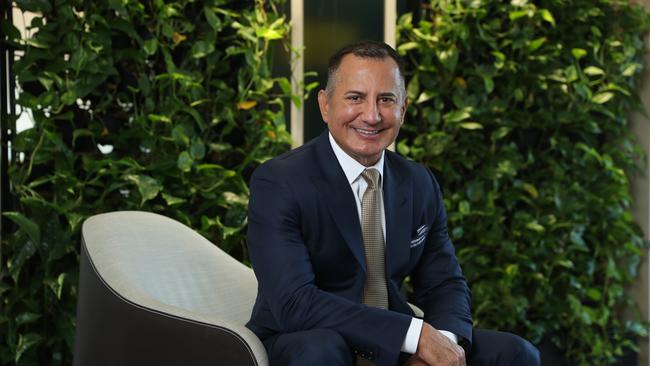Bank of Queensland optimistic on net interest margin as cash profit rises 14pc to $268m
The Brisbane-based lender’s shares tumble amid questions over its loan growth strategy.

Bank of Queensland shares tumbled more than 6 per cent on Thursday as the market reacted to a lower-than-expected interim dividend payout and question marks over the lender’s growth strategy.
BoQ shares closed the session at $7.99, down 6.3 per cent, even as the lender saw a jump in cash earnings for the first half and as CEO George Frazis sounded a note of optimism on easing margin headwinds.
“Our sense is that net interest margin pressures are definitely are abating. There’s still some flow-on in terms of settlement for fixed (rate loans), but applications are definitely down and with the interest rate increasing environment, banks are generally advantaged,” Mr Frazis told The Australian.
“A further benefit is ME Bank, which has really been a drag on our revenue this year. That moves to become a tailwind for us next year, which is really pleasing.”
BoQ grew above system in both the home loan and business segments in the half, but its net interest margin, a key measure of profitability, dropped 12 basis points to 1.74 per cent, worse than expected.
Flows to fixed-rate loans jumped to 47 per cent over the six months but had fallen sharply, to about 18 per cent, in recent weeks, Mr Frazis added.
It comes as lenders hike fixed rates as markets price in higher funding costs. On Thursday, all of the big four banks had four and five-year fixed rates well in excess of 4 per cent, while NAB was the only one of the four to have a three-year rate under 4 per cent.
This contrasts with a year ago, when many lenders were offering three-year terms under 2 per cent and four and five-year terms below 3 per cent.
Mr Frazis sees the housing market slowing over the medium term but is more optimistic on the price outlook than others, like Commonwealth Bank, who see property prices going backward by the end of 2023.
“Our view is there was really strong price appreciation last year of over 20 per cent, we’re going to get something like 8 per cent this year and probably a pretty flat next year before maybe a decline.
“Even if you take all of that into account, homeowners have quite a bit of equity in their home so they’re still in a very good position.”
Mr Frazis’ remarks come weeks after the nation’s largest bank warned property prices would fall 8 per cent through 2023, and as the Reserve Bank’s own estimates indicate prices could drop as much as 15 per cent if rates rise 2 per cent.
For the six months through February 28, the Brisbane-based lender recorded a 14 per cent rise in cash profit, to $268m, while statutory net profit slipped 5 per cent to $212m.
It follows BoQ’s near $1.33bn acquisition of ME Bank, which completed in July.
Cash earnings through the half reflected the bank’s momentum, focus on costs and the benefit of lower loan impairment expenses, Mr Frazis added.
Morningstar banking analyst Nathan Zaia said there were positives and negatives in the result.
“They’ve been doing a good job on the lending side, growing above system, but the margin pressure was a little bit worse than we expected. In this type of environment, it’s hard to tell how much of it is the bank using prices as its lever to grow share and it looks like there has been a little bit of that going on,” Mr Zaia said.
“In saying that, they’ve also done a good job in growing the cheapest sources of funding, like ransaction deposits. The question is longer term will they still be able to grow those transaction deposits much faster than the rest of the market as term deposit rates rise.
The dividend was another miss, Mr Zaia added.
“We’re talking about the major banks returning surplus capital to shareholders and BoQ is here being a bit stingy on the dividend.
“There’s also a discount on the DRP. So I think it’s a big contrast between the positions that the majors are in and these regional lenders.”
BoQ declared a 22c a share interim dividend to shareholders, representing just a 53 per cent payout ratio as it looks to invest in its mult-year transformation. The payout ratio is much lower than its target range of 60-75 per cent of cash earnings.
Over the six months, BoQ saw housing loan growth of $2.6bn, a 9 per cent lift on the prior half, while business loan growth increased 8 per cent, or $0.6bn.
Mr Frazis said the lender was “cautiously optimistic” that the nation remains well placed for economic recovery.
“Cash rate rises appear increasingly likely as the recovery continues and inflation rises. BOQ remains focused on achieving quality, sustainable, profitable growth and delivering 2 per cent positive jaws for fiscal 2022.” Positive jaws occurs when gross income rises faster than costs.
The bank expects its CET1 ratio to remain “comfortably” above 9.5 per cent.




To join the conversation, please log in. Don't have an account? Register
Join the conversation, you are commenting as Logout